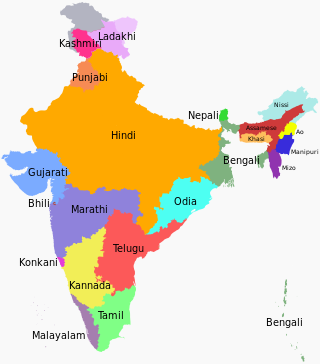
Back الحزام الهندي Arabic हिंदी पट्टी Bihari হিন্দি বলয় Bengali/Bangla Hindivyöhyke Finnish Ceinture hindie French हिंदी की विभिन्न बोलियाँ और उनका साहित्य Hindi Sabuk Hindi ID हिन्दी इलाका Nepali ہندی بیلٹ PNB Пояс хинди Russian
This article needs additional citations for verification. (December 2015) |
Hindi Belt | |
|---|---|
Region | |
 Area (red) where various languages considered by the census as Hindi are spoken natively | |
| Country | |
| Major urban agglomerations (2011 census) | |
| States and Union Territories | |
| Area | |
| • Total | 1,355,456 km2 (523,344 sq mi) |
| Population (2011)[2] | |
| • Total | 563,766,118 |
| • Density | 420/km2 (1,100/sq mi) |
| Demonym | Hindi Bhashi |
| Time zone | UTC+5:30 (IST) |
| Scheduled Languages | |

The Hindi Belt, also known as the Hindi Heartland, is a linguistic region encompassing parts of northern, central, eastern, and western India where various Northern, Central, Eastern and Western Indo-Aryan languages are spoken, which in a broader sense is termed as Hindi languages, with Standard Hindi (based on Dehlavi) serving as the lingua franca of the region.[4][5][6][7][8]
The term "Hindi belt" is sometimes also used to refer to the nine Indian states whose official language is Modern Standard Hindi, namely Bihar, Chhattisgarh, Haryana, Himachal Pradesh, Jharkhand, Madhya Pradesh, Rajasthan, Uttar Pradesh and Uttarakhand, as well as to the union territory of Chandigarh and the National Capital Territory of Delhi.[9][10][11][12]
It is also sometimes broadly referred to as the "Hindi–Urdu Belt" or "Hindustani Belt".[13]
- ^ "Largest State in India 2022: Check the list of all states by area and population". 16 February 2022.
- ^ "A-1 No of Villages, Towns, Households, Population and Area". Office of the Registrar General & Census Commissioner, India. Retrieved 3 March 2024.
- ^ "Report of the Commissioner for linguistic minorities: 50th report (July 2012 to June 2013)" (PDF). Commissioner for Linguistic Minorities, Ministry of Minority Affairs, Government of India. Archived from the original (PDF) on 8 July 2016. Retrieved 26 December 2016.
- ^ B.L. Sukhwal (1985), Modern Political Geography of India, Stosius Inc/Advent Books Division, ISBN 9780865906082,
... In the Hindi heartland ...
- ^ Stuart Allan, Barbie Zelizer (2004), Reporting war: journalism in wartime, Routledge, ISBN 0-415-33998-7,
... located in what is called the "Hindi heartland" or the "Hindi belt" of north and central India ...
- ^ B.S. Kesavan (1997), Origins of printing and publishing in the Hindi heartland (Volume 3 of History of printing and publishing in India : a story of cultural re-awakening), National Book Trust, ISBN 81-237-2120-X
- ^ "Battle for the Hindi heartland: Will it favour the BJP again?". www.orfonline.org.
- ^ "Congress' revival in Hindi patti". www.nationalheraldindia.com. 8 February 2019.
- ^ "How languages intersect in India". Hindustan Times. 22 November 2018.
- ^ "How many Indians can you talk to?". www.hindustantimes.com. Retrieved 22 December 2019.
- ^ "Hindi and the North-South divide". 9 October 2018.
- ^ Pillalamarri, Akhilesh. "India's Evolving Linguistic Landscape". thediplomat.com. Retrieved 22 December 2019.
- ^ Khan, Abdul Jamil (2006). Urdu/Hindi: An Artificial Divide: African Heritage, Mesopotamian Roots, Indian Culture & Britiah Colonialism. Algora Publishing. p. 313. ISBN 9780875864389.
In the 'Hindi-Urdu belt' also these variations are visible
Cite error: There are <ref group=lower-alpha> tags or {{efn}} templates on this page, but the references will not show without a {{reflist|group=lower-alpha}} template or {{notelist}} template (see the help page).
© MMXXIII Rich X Search. We shall prevail. All rights reserved. Rich X Search